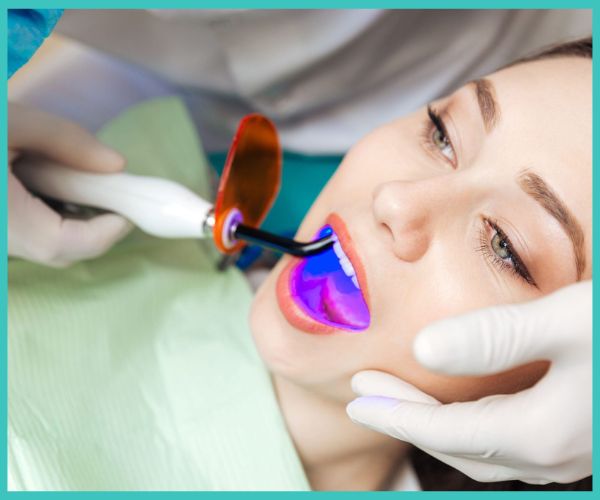

What is a Teeth Whitening?
Teeth whitening is the process of removal of discoloration from the teeth. It is a non-invasive method. Visible results can be obtained after getting your teeth whitened in your dentist’s office. However, it needs to be borne in mind that the process of Teeth Whitening is not permanent and it requires visiting the dentist for maintenance.
Who can get Teeth Whitening?
– Anyone who has an external teeth stain can get their teeth whitened.
– People who have stained their teeth beyond a point by chewing pan, tobacco can get their teeth whitened.
Dental Stain Types
There are two types of stains, namely intrinsic and extrinsic stain that can happen to your teeth.

Intrinsic Stain
The stain happening in the layer of dentin is called Intrinsic Stain. Generally, it is not seen if the enamel layer is present. If the enamel begins to wear out, the stain on the dentin gets exposed.

Extrinsic Stain
If the outer protective enamel is stained, this type of stain is referred as an Extrinsic stain.

Removal of Stains
Only extrinsic stains can be removed by teeth whitening. There are two methods of removal of stains. They are In-office teeth whitening and In-office laser teeth whitening.
- First, the gums are protected with a barrier.
- The trained dentist then applies recommended whitening agents to your stained teeth. The dentist knows the amount of whitening agent to be used. The whitening agent is usually some form of peroxide.
- This applied whitening agent is left on the surface. It is left for some time to permit oxidizing to take place so that stains are removed. The oxidizing is affected by light. The time to be left is decided by the dentist depending on the intensity of the stains. The dental area is then rinsed thoroughly.
- Your dentist would repeat this process for 3-4 times again depending on the intensity or type of the of the stain on the same day.
- Similar to the previous method, first the gums are protected with a barrier.
- The trained dentist then applies recommended whitening agents to your stained teeth. amount of whitening agent (some form of peroxide) used is slightly higher if the stains os of intrinsic type.
- This applied whitening agent is left on the surface. Then the laser is beamed onto the surface. The dentist would focus the laser for a given time depending on the intensity of the stain. Instead of light that oxidizes the whitening agent, the role is now taken over by the laser.
- Laser dramatically enhances the results and makes your teeth whitened.
- The dental area is then rinsed thoroughly.
- Your dentist would repeat this process for 3-4 times again depending on the intensity or type of the of the stain on the same day to achieve the best possible result.
- One of the main advantages of this type is that sensitivity is minimal to the teeth compared to the other in-office method.
There will be sensitivity so they have to be regular on a desensitizing toothpaste which will be prescribed by the doctor. Sensitivity will be less in laser teeth whitening.
- They need to be conscious of what you eat if you want to avoid staining your teeth. Generally, as a ground rule avoid dark colored beverages for a week after getting your teeth whitened.
- After a week’s time, you can sip dark beverages. But the better option would be sip by a straw as you want to avoid them staining your teeth once again.
- Brush your teeth twice a day and floss at least once a day to maintain proper oral hygiene.
- Drink water after drinking any beverage.
- Your teeth are not going to be milky white after Teeth whitening. Such milky white teeth are unnatural.
- The full results of the Teeth whitening process can be seen only after 2-3 weeks of whitening as the crevices on the enamel which has been cleaned for their stains will start filling with calcium deposits. It is these calcium deposits that give the typical white color to the teeth. Hence you need to wait to see results.
- If your gums have receded, they show up some tooth layer. It should be noted that removal of stains from this area is indeed challenging.
- Teeth that are white and devoid of stains are aesthetic in nature.
- Aesthetic and healthy teeth provide more confidence in a person and definitely increases one’s personality.
Other Cosmetic Dentistry Procedures

Gum Contouring
When natural teeth are sunk inside an excess gum and bone, they are unpleasing. In crown lengthening, they are reshaped surgically.

Crown Lengthening
When natural teeth are sunk inside an excess gum and bone, they are unpleasing. In crown lengthening, they are reshaped surgically.

Dental Veneers
Veneers or laminates are thin materials made for covering the front surface of the teeth. They are custom-made shells and are tooth-colored.

Jaw Corrections
Surgically correcting longer or shorted upper or lower jaw can help rectify bite related problems. They also help create an aesthetic face.
Appointments
Lorem ipsum dolor sit amet, consectetuer adipiscing elit. Aenean commodo ligula eget dolor. Aenean massa. Cum sociis natoque penatibus et magnis dis parturient montes.
